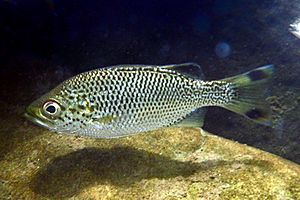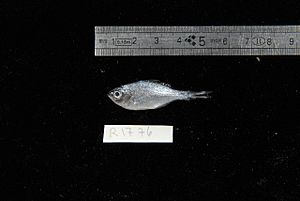Rock flagtail facts for kids
Quick facts for kids Rock flagtail |
|
|---|---|
 |
|
| A Jungle Perch, Kuhlia rupestris, in the Yuchingawa River, Iriomotejima Island, Japan | |
| Conservation status | |
| Scientific classification | |
| Synonyms | |
|
The Jungle Perch, also known as Kuhlia rupestris, is a cool fish that lives in both fresh and saltwater. It has many nicknames like rock flagtail and mountain trout. This fish belongs to a group called flagtails.
Jungle Perch are special because they are catadromous. This means they live mostly in freshwater but travel to the sea to lay their eggs. You can find them in the Indo-Pacific region and northern Australia.
Contents
What Does a Jungle Perch Look Like?
The Jungle Perch has a body that is a bit flat from side to side. Its head is pointed, and its mouth can open wide. It also has big eyes.
Its top fin, called the dorsal fin, has a deep notch. The tail fin, or caudal fin, has rounded parts. The fish is usually brown or olive green on top. Its sides are silvery, and its belly is white.
You might see dark or reddish-brown spots on its sides. Its tail often has a black spot on each lobe. In older fish, these spots can join together to form a dark bar.
Where Do Jungle Perch Live?
Jungle Perch are found in a huge area across the Indian and Pacific Oceans. They live off the coast of eastern Africa, from Somalia all the way down to South Africa.
They also swim across the Indian Ocean to the western Pacific. You can find them as far north as the Ryūkyū Islands in Japan. To the south, they reach Australia. In Australia, they live from the Gulf of Carpentaria down to southern Queensland. They also live as far east as Fiji, Samoa, and the Caroline Islands.
Habitat and Life Cycle
Jungle Perch love fast-moving freshwater streams and rivers. They often live in rainforest areas. However, they can also be found in estuaries (where rivers meet the sea) and coastal waters. They can live at high altitudes, up to about 240 meters (787 feet) above sea level.
These fish are often seen in rocky pools below waterfalls. They are migrants, meaning they travel. They must move from freshwater to the sea to reproduce. Scientists think they follow floodwaters out to sea during the wet season to lay their eggs.
Jungle Perch are omnivores, which means they eat both plants and animals. Their diet includes insects, small fish, and crustaceans like crabs. They also enjoy eating fallen fruit, especially figs.
Conservation Status
Jungle Perch are popular with people who like to fish. Anglers find them smart because they quickly learn to avoid fishing lures. In Queensland, there are rules about how many of these fish you can catch.
The IUCN says the Jungle Perch is a species of "Least Concern". This means they are not currently in danger of disappearing.
However, their homes are being damaged. Things like dams and other barriers in rivers can block their paths. This makes it harder for them to move between fresh and saltwater to complete their life cycle. These changes can reduce their numbers in some areas.



